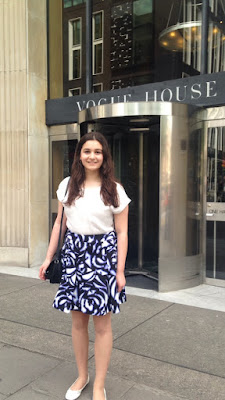Vogue Entry #1 Interview
The Jersey Girl: 50 years in fashion
The career of fashion designer Steffi Kester “the Jersey Girl” spanned half a century from the 1940s. I met Steffi in her stylish flat at the top of the iconic modernist Highpoint block. We sat together, overlooking the spectacular views of London. An enchanting and intriguing character, Steffi is a dignified woman in her late 80s, but her face betrayed the excitement and wonder of a young girl, eager to share her story. She had a warm, welcoming smile and I immediately relaxed in her company.
In February, the New York Times reviewed this year’s collections at London Fashion Week. They called it “the end of austerity” as designers rejected David Cameron’s call to “live within our means”.
As she looked back on her own career, Steffi remembered another “end of austerity”, as the rationing of the 1940s and the social conventions of the 1950s gave way to the plenty and freedom of the 1960s.
I would have never guessed from her refined British accent, that her story begins in Chemnitz, Germany. In 1939, she arrived in England on the Kindertransport having narrowly fled the genocide that was about to consume six million of her people. She was a shy and frightened 12 year old, living with strangers and missing her family desperately. In sharp contrast with her settled and classically furnished apartment in London, home for Steffi as a refugee during the war consisted of 9 different addresses.
She tells me that her original love for fashion came from her father, a textile factory owner in Chemnitz. She was fascinated by the fabrics and colours and would craft small clothes for her dolls using leftover scraps. This love of design continued and she was offered a scholarship to the Birmingham School of Art.
At the age of just 17 she was taken by her teacher to see an exhibition of French Couture designers in London ‘and that’ she says ‘really sparked me off.’
Paris has always been her inspiration. Despite the war, Steffi felt that France was very much ahead of America, ‘their work attracted me because it was sculptured, not just sewn together. The couturiers had enormously good taste and refinement which I think lifted the fashion scene for a long time afterwards.’
By an extraordinary stroke of luck, Madge Garland, the editor of British Vogue at the time was attending the same exhibition. She spotted young Steffi making sketches of the clothing, ‘Ms Garland’ Steffi describes ‘was a very elegant, charming lady. My icon.’
Madge Garland, who also worked for the department store Bourne and Hollingsworth, offered Steffi a job there immediately. So there Steffi sat, safely ensconced in a small design studio of her own, ‘I was all of 18 and in heaven’. However, with rationing still firmly in place, her resources were limited. She had to do simpler designs that would fit into government restrictions and cultural demands.
In 1948 she was offered a position in New York. For an 21 year old budding designer, New York was an urban paradise, I could see the excitement in her face as she remembered her whirlwind trip as a wide-eyed young girl. ‘In America there was everything... interesting novelties of all kinds which in England you wouldn't have.’
However her time there was cut short. She had to return home because her father had died. Soon afterwards, she got married and set up her own fashion label.
It was her Knitwear and Jerseywear designs which earned her the name “Jersey Girl” in the press. Her pieces were timeless. ‘I loved and still do love classic designs in good colours.’
Then the 1960’s rolled around and people started to dress in a manner which suited them, ‘that’s much more important than trying to look like somebody else.’
She remarks that 'a designer has to have eyes everywhere and their ears open...fashion adapts to the time that you live in, people cannot walk around in Edwardian skirts and jump on a bus and rush off with a briefcase, the history of what is happening influences the design of almost everything’.
At the end of our meeting, she presented me with a file containing press cuttings, photographs and letters she accumulated over her extraordinary career, and urged me to take it home to look at. I sat at home studying her portfolio containing almost 50 years of work, including photographs of her timeless designs. The small green folder holds a lifetime of achievements, pride and hard work. For Steffi, the end of austerity was marked by the freedom of expression which exploded in the 1960s. We have yet to see what the end of our own era of austerity will bring to the world of fashion.

Comments
Post a Comment